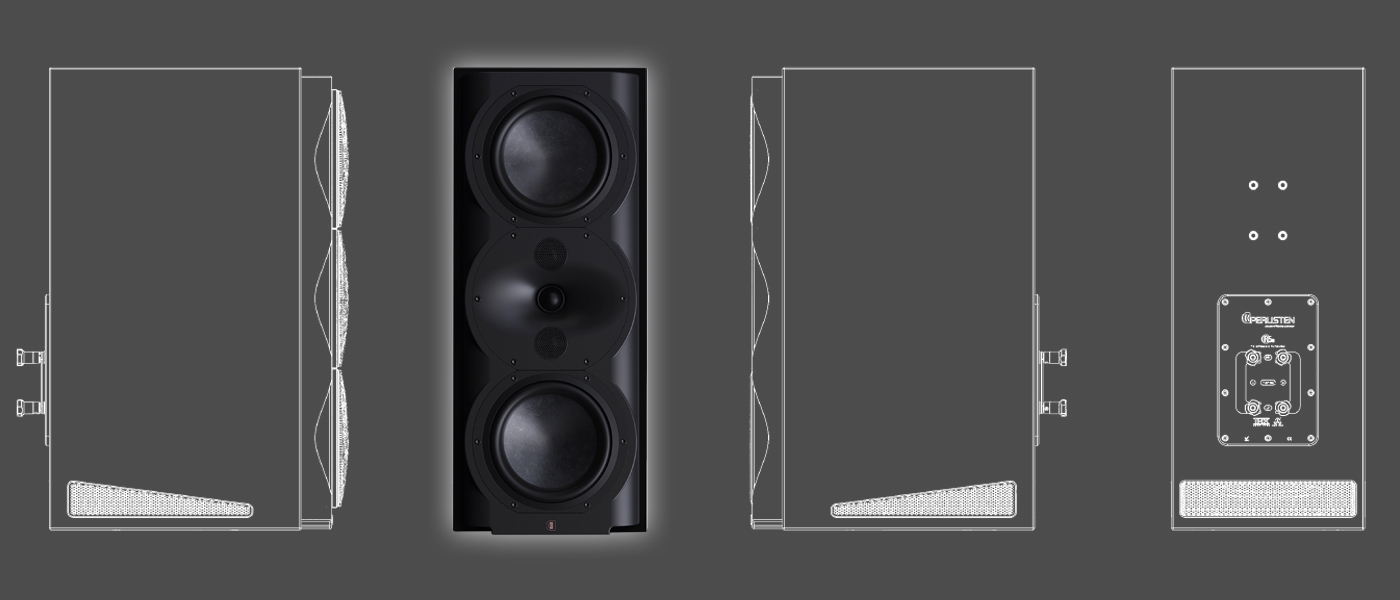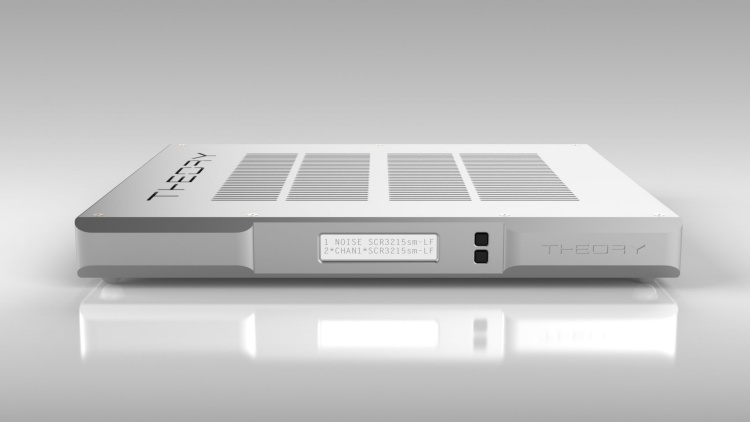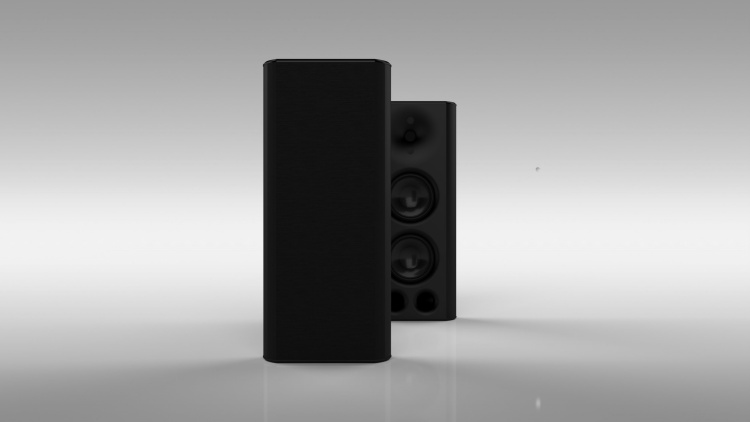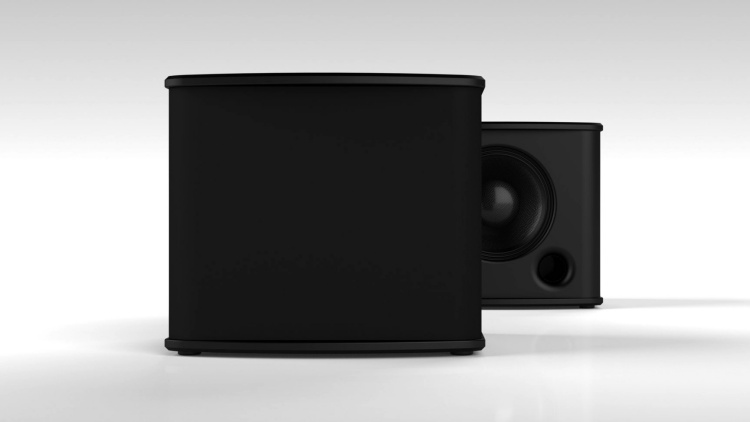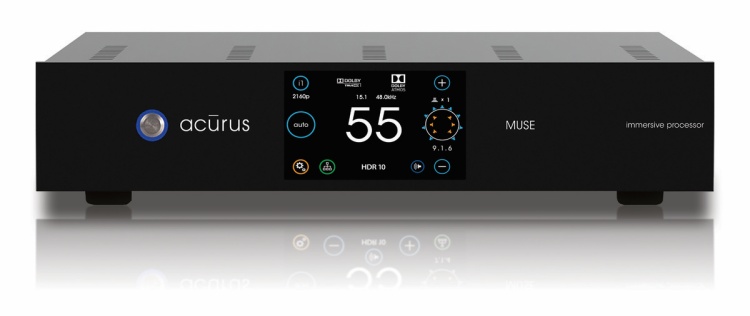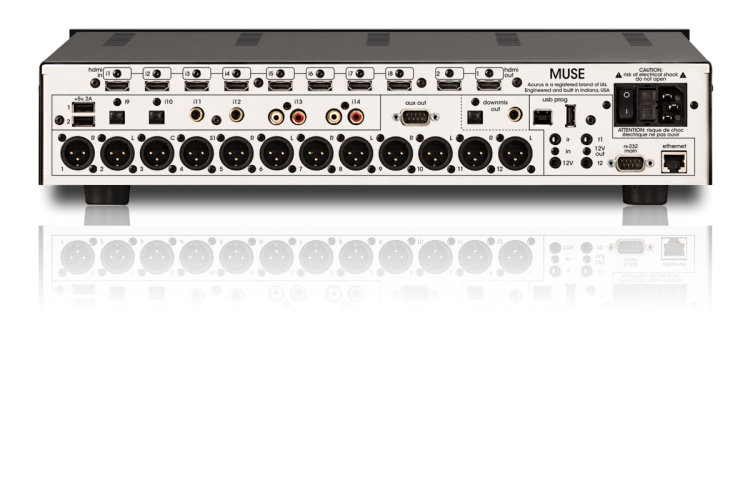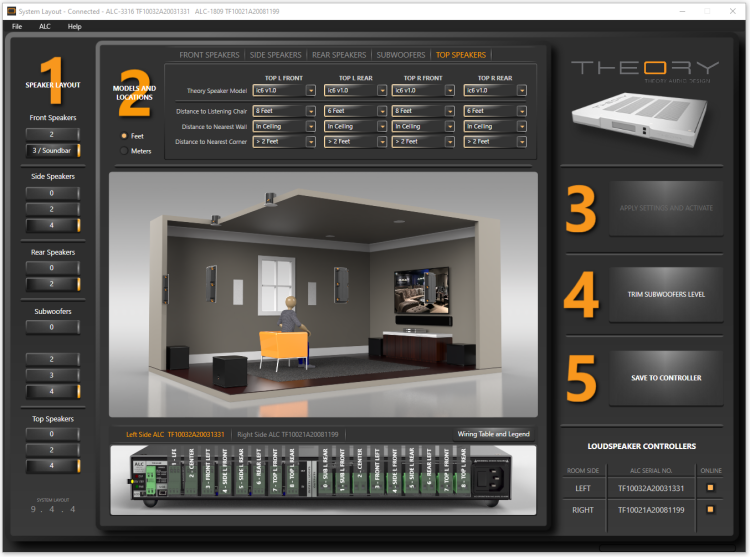Featuring dual 15” subwoofers, and compact, high-performance surface-mount loudspeakers, the Theory surround system is controlled by a slim chassis unit that provides power and control for all the Theory loudspeakers. Aided by the Acurus Muse immersive pre-amp/processor, the Theory sound system will transport you to otherworldly sonic pleasure.
On both music and film, the Theory Audio Design system when paired with the Acurus Muse pre-amp/processor produced some of the best sound I have heard to date. The Theory system main speakers, which can be configured for stereo, surround, or Atmos can be purchased as surface, on-wall, or inwall units. The system can be integrated easily into any room décor.
Theory Audio Design 5.2 System
- Compact Multipurpose High Output Loudspeaker System
- High Output Passive Subwoofer System
- 9-Channel Amplified Digital Loudspeaker Controller
- Automatic Configuration of Surround System Settings
- Loudspeaker Processing for all Theory and PRO Models
- Surround Formats Supported: 3.1, 3.2, 3.3, 5.1, 5.2, 5.3, 7.1, 7.2, 5.2.2 ATMOS
The Theory Audio Design 5.2 surround system that I have in for review, which consists of 5 surface-mount satellites, two 15” subs, and a controller/amplifier, may not be familiar to many music and audiophile listeners. I was not familiar with them either but soon found out that the man behind Theory has a history in High-End sound. L. Paul Hales the founder and chief engineer at Theory is the same L. Paul Hales that was the head of the storied Hales loudspeakers of the early 1990s. The Hales System Two Signature Loudspeaker was given a tremendous review by Stereophile contributor Robert Harley in 1990. At the time, Robert Harley considered it a world-class loudspeaker. Many decades later, L. Paul Hales offers a unique and updated system solution for discriminating listeners.
Sb25 Surface Mount Loudspeaker
Description:
Compact Multipurpose High Output Loudspeaker System
Operation:
Passive, Requires 1 THEORY ALC Amp channel
Drivers:
2 x 5″ THEORY Carbon Fiber Low-Frequency Driver
1 x 1.4″ THEORY Advanced Polymer Compression Driver
Bandwidth:
58Hz -23kHz
Sensitivity:
94dB-108dB SPL
Power Handling:
200W (AES)
Power Requirements:
Requires THEORY Amplified Loudspeaker Controller
Maximum Output:
117dB
Nominal Impedance:
4-ohms
Colors:
Black
Accessories:
sb25 Universal Mount Adapter, sb Tabletop Stand
Dimensions:
21.5″ H x 9.5″ W x 3.8″ D
Weight:
23 lbs.
List Price each:
$850.00
Sub15
Description:
High Output Passive Subwoofer System
Operation:
Passive, Requires 1 THEORY ALC Subwoofer Amp channel
Drivers:
1 x 15” THEORY Woofer w 4-Inch Voice Coil
Bandwidth:
22Hz – 125Hz
Sensitivity:
96dB
Power Handling:
500W (AES), 1000W Continuous
Power Requirements:
Requires THEORY Amplified Loudspeaker Controller
Maximum Output:
124dB
Nominal Impedance:
4-ohms
Colors:
Black
Dimensions:
21.3” H x 23.5” W x 19.8” D
Weight:
76 lbs
List Price Each:
$1500.00
ALC 1890 Loudspeaker Controller
Description:
9-Channel Amplified Digital Loudspeaker Controller
Inputs:
8 x Balanced Analog Audio w Loop Outputs (1 mic/line level switchable)
Outputs:
9 x Speaker Outputs
8 x Balanced Analog Audio Looping Outputs
12VDC/Contact Closure Trigger Loop Output
Trigger:
+12VDC or Contact Closure Trigger Input w Loop
Surround Formats Supported:
3.1, 3.2, 3.3, 5.1, 5.2, 5.3, 7.1, 7.2, 5.2.2 ATMOS
Audio Operation:
96kHz/24-bit
On-Board DSP:
96kHz/32-bit
DSP Features:
Automatic Configuration of Surround System Settings
Loudspeaker Processing for All Theory and PRO Models
Input Trim
Signal Routing
Gain
Delay (up to 75msec per channel)
160 Parametric EQ Filters (20 per channel)
8 x 8 Parametric Bass Management (Bass Steering)
Mono Summing: 8 Stereo + 4 mono Signals
Bass and Treble Controls
Master Volume
Clip Limiter
Internal Sine and Pink Noise Sources
Bandwidth:
5.5Hz-40.6kHz, -6dB
Frequency Response:
20Hz-20kHz, +/-0.2dB
Amplifier Power Output:
Channels 0-1-2: 300W, 4-ohms
Channels 3-8:
100W, 4-ohms, bridgeable to 300W*
Voltage Gain (all channels):
30dB
Input Sensitivity:
Channels 0-2: 1.1V
Channels 3-8: 660mV
Power Requirements:
Standby: 16W
Idle: 41W
(1/8 power, all ch. driven): 281W
Idle Noise (speaker program, typ., A-wt.):
Channels 0-2: -82dBV (0.00008V)
Channels 3-8: -80dBV (0.00010V)
Signal to Noise Ratio:
Channels 0-2: 108dB
Channels 3-8: 105dB
Distortion (1kHz, 1dB below max output):
<0.02%
AC Operation:
100V-240VAC, 50-60Hz
Finish:
Matte Bright Aluminum
Dimensions:
1.75″ H x 17″ W x 15″ D
1.75″ H x 19″ W x 15″ D w Rack Ears
Accessories:
8 x Euro-to-XLR Adapters Included
Software:
Theory Music and Surround Automator™
Auto system configuration tool
Weight:
13 lbs
*Bridged channels ok for sb speaker models only, not for subwoofer use.
List Price Each:
$3500.00
Acurus Muse Immersive Preamp/Processor
Frequency response:
20 – 20kHZ ± 0.1 dB
SNR:
>110dB (A-wt)
THD:
< 0.02% (20 – 20kHz)
Stereo Analog Inputs:
2 X Gold Plated RCAS L/R Unbalanced
Digital Inputs:
2 X Coax RCA, 2 X Optical
Multi-channel Analog Outputs:
12 X Balance XLR + 4 X CAB-20 Bal. XLR
Digital Outputs:
1 X coax RCA, 1 X Optical
Digital Video Inputs:
8 X HDMI 2.0b (2.1 ready), 4K pass-thru
Digital Video Outputs:
1 X HDMI 2.0b (2.1 ready), 1 X 2.0b
Front Panel Display:
5” LCD touch-panel
Serial:
2 X DB9, 2-way control, 2 X USB programming ports
Ethernet:
1 X ethernet, web interface + TCP/IP control
12V Trigger and IR:
1 X 3.5mm In, 2 X 3.5mm Out, IR Remote
Charging Port:
2 X USB 5V, 2A
Dolby Atmos Native Decoding:
15.1
DTS:
X Native Decoding: 11.1
Post Processing:
Dolby Surround Upmixer, DTS Neural: X Upmixer
Loudspeaker Adjust (I):
Delay, Polarity, Large/Small, Crossover
Loudspeaker Adjust (II):
PEQ
Loudspeaker Adjust (III):
ASPEQT Room Correction System
Product Dimensions:
3.5” X 17” X 15”
Product Weight:
23 lbs.
Finish:
Black Satin Anodization, Laser-Etched Logo, White Chassis
MSRP:
$6499.00
The Theory Audio Design 5.2 system is very different from what other manufacturers offer today. I would say it is an all-in-one package designed to provide the ultimate playback of movies and music. The end-user will only need to provide a surround decoder pre-amp and source. This can be an advantage for those upgrading since most people will have an existing surround receiver and or a surround preamp available.
It is best to think of the Theory system as an amplified speaker array. The Theory ALC-1809 9-Channel Amplified Digital Loudspeaker Controller unit will provide the power for the speakers (in this case the sb25 surface-mount speakers) and subwoofers (the sub15 woofers). The advantage of this kind of approach is that the amplifier will be optimized for each speaker. All the variables that one would encounter in trying to match an amplifier with speakers become a non-issue and is instead one of the strengths of this design. The end-user will not need to worry if they are getting all the performance out of their speakers and amp. Electrically and mechanically, the amp and speakers will operate at their best. They are like a good team, kind of like Olympic synchronized divers. Note that the amp will also adjust for delay. When you use a surround pre-amp, be sure not to set the delay parameters on the pre-amp unit.
In use, Theory Audio offers a download of the software that allows the installer to set up the system. Theory offers in-wall, as well as on-wall speakers, and there are 2 different sizes of subs, a 15 inch and a 12 inch. By using the software, the installer can tailor the speakers to the room by electronically adjusting the physical positioning of the speakers to the listening seat.
The speakers appear to be built to very high standards, pro-standards if I may say. The sb25 on-wall speakers sent to me are seriously heavy and come with a heavy-duty bracket for wall mounting. A self-mount stand is available for use on a stand or on a shelf and I was able to get the stands for this review. The subs are large and heavy, but very nice looking.
Because the speakers and amp are designed to work with each other, the speakers will not operate properly without the ALC-1809 amplifier. For this review, I was sent five sb25 surface-mount speakers and two sub15 woofers. Theory systems can accommodate up to 7.2 and 5.2.2 Atmos installations. For more information, please visit their website Theory Audio Design.
The first thing I did to prepare for set up was that I downloaded the Automator software to my computer from the Theory Audio web page. The Automator software allows the installer to input settings into the Theory ALC-1809 amplifier controller amplifier. Once installed I used the cable provided by Theory to link my computer to the Theory ALC-1809. At the beginning of the review period, Theory was in the process of updating their software, so I used the opportunity to set up the Theory package as a 2.2 system. My impressions of music playback were taken from this initial setup. When the new software was available, I then deleted the initial version and installed the new Automator V 2.0 software from the Theory webpage, and proceeded to install the settings for a 5.2 system. The video/film impressions were done using the new Automator V 2.0 version.
Once the software was installed, I called on my old friend Matt. Matt is a member of the River City Audio Society, and we like to share time on our audio hobby. He helped me unbox and connect the speakers to the ALC-1809 controller amp and an Acurus Muse preamp/processor. The Acurus Muse is a complete 16 channel preamp/processor that was loaned to me for this review and a big thank you is due to the folks at Acurus for this favor. www.acurusav.com – MUSE
I had mentioned that the subs (the Theory sub15 speakers) were large and heavy. This is when it pays to have good audio friends like my friend Matt that visit the gym. Matt was able to help me lift and place the subs in position and then connect the speaker wire to the amp and all speakers. (The Theory ALC-1809 controller amp has the processing built in to adjust for the crossovers, delay, and room for the speakers in the Theory speaker system.)
The Acurus Muse was connected to the Theory ALC-1809 with high-performance XLR cables. For source, we used the Blue Sound Node music streamer (a great device) connected via digital optical, an Amazon Fire Stick connected to the Muse via HDMI, and a turntable, the Pro-Ject Juke Box S2 connected via analog RCA (the Pro-Ject Juke Box S2 has a built-in phono stage). Pro-Ject Juke Box S2 Review – HomeTheaterHifi.com In addition, I connected my Samsung TV via optical out and HDMI ARC to the Acurus Muse (the Acurus Muse will accept a multitude of inputs and outputs).
Once everything was in place, I connected the Theory ALC-1809 to my computer via the provided cable. On the new software, the setup is basically a 5-step process. First, the app will ask how many Theory ALC-1809’s you will use. Then in step one, the installer selects the speaker layout (2.0, 2.1, 5.1, etc.). When you select, the app shows the speakers in the picture. Step two, the installer selects the speaker models being used. After the installer selects the speaker models the installer will enter in drop-down boxes the distance of each speaker to the listening chair or couch, the distance from the wall (or on the wall), and the distance from the nearest corner of the room. This is the most time-consuming part of the setup. When you are ready, you will go to step 3 and apply and activate your settings. Next in step 4, the installer will adjust the bass level. When that is done, step 5 will ask you to send the settings to the memory of the ALC-1809 controller. After a few minutes, you are done. I found the experience both fun and easy, especially since I played with the settings a few times to set the bass level (I set the level by ear and of course to my preference).
When we were done with the initial set up my buddy Matt remarked how elegant and well designed the Theory system was. I have to agree. The quality of the build and the ease of installation are noteworthy. Now came the moment of truth, Matt and I needed to hear how the system sounded in 2-channel with dual subs. The initial phase of the review was in 2-channel as we waited for the update to the current Theory Automator app. Just to make sure everything would fire up; Matt and I played some records he brought from home on the Pro-Ject Juke Box S2. The install was a success. Playing a record of James Brown hits brought us into instant party mode. Right away I heard the timing and dynamics of the music that gave it a terrific jump factor. I couldn’t wait to hear more.
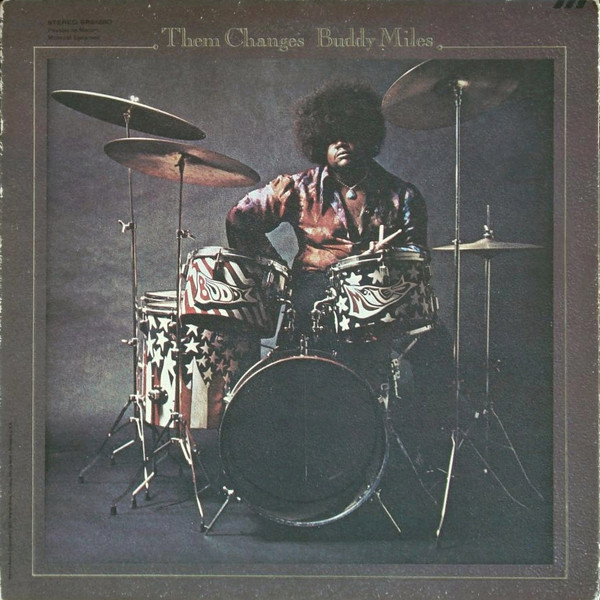
I like to listen to music that I have grown to love on systems that I review. Buddy Miles and his “Them Changes” LP are one of them. This LP was a part of my coming of age in the early 1970s. I remember buying the LP when it first was available and just grooving to the music with my friends after school. Little did I know then that decades later, I was to meet the man who recorded the album, Alan Hendler.
Alan was a member (original member like me) of the River City Audio Society. Alan and I struck up a friendship ten years ago that lasted until his death last year. I remember Alan as having a strong opinion on everything audio, from amps to speakers, to recording techniques. One day when I was visiting Alan, I found a copy of Buddy Miles Them Changes LP in his collection. I was surprised because Alan usually listened to classical and soundtracks, and that’s when he revealed that he was the engineer on that record.
Alan had a great system at home which included Magnepan III speakers driven by Berning OTL tube amps, and Audio Note preamplification. Alan cued up “Down by the River” from the Buddy Miles Them Changes LP on Tidal that day and let it rip. The opening guitar solo on this track is one of the nastiest, howling solos you will ever hear. It was reproduced in a haunting and deeply resonating way. I was on the edge of my chair, and I just slumped back into the chair as I was struck by the musical current. Alan looked at me beaming with pride because he had been a part of this record. So, how does this track compare when played back on the Theory system? Did it get the nasty right?
The answer is most definitely yes! The guitar exploded from the speakers and the snare drum sizzled and spit, and when the voices and drums came in, they were soaring. The soundstage was huge. Tonality was wonderful and I could hear Buddy Miles’s voice reproduced with his characteristic nasality. Even though the Theory sb25 surface mount speakers are against the wall, the sound was very dimensional. Most audiophiles will look for soundstage depth and height and find it in some mini-monitor speakers or even more so on planar speakers like the Magneplanars. I must report that the dimensionality coming from these on-wall speakers rivaled the Magneplanars. The imaging and focus were pin-point sharp. With sadness in my heart, I would like to think that my friend Alan would have enjoyed hearing this system.
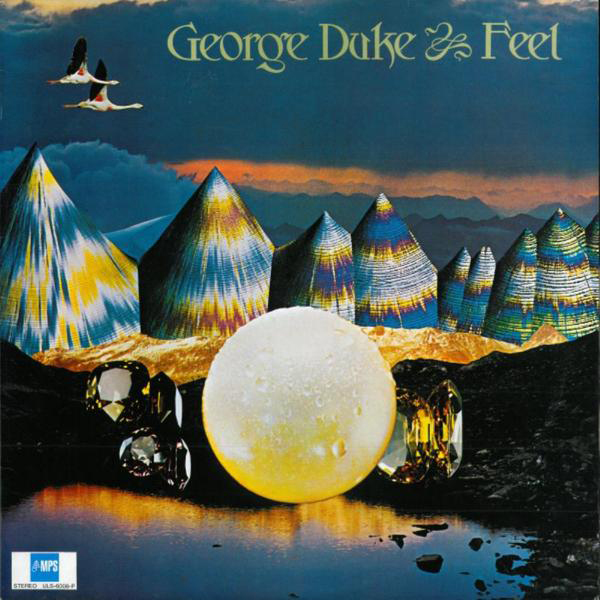
Another album I have enjoyed over the decades is George Duke’s space funk experimental jazz (for its time) LP, “Feel.” I purchased the album in 1974 when it was first released, and for the review, I used the streaming service Qobuz to play the music. When the opening track, “Funny Funk” began I was propelled by the snappy drums and funky synthesizer syncopation of the music. Immediately my toes started tapping and the reproduction by the Theory system made me want to get up and dance. On the following track, “Love” when George Duke starts singing the Theory system places him dead center and a little behind the monitor screen. George Duke’s voice was reproduced with proper weight and rock-solid focus. When the searing guitar by Obdewl’l X comes in it was reproduced with nuance and finesse and appropriate searing thunderbolt clarity. (Obdewl’l X is a pseudonym for Frank Zappa)
My buddy Matt (who is a big Zappa fan) tells me that the name Obdewl’l X is the name for a character in Frank Zappa’s opera, Thing Fish. The collaboration with Zappa is no coincidence as George Duke was a member of Zappa’s band at the time. Fortunately, I was able to see Frank Zappa, George Duke, and Captain Beefheart together during the Bongo Fury Tour of 1975. Those were the days! I sadly lost my copy of Thing Fish, but Matt has his.
As I continued to listen to this very familiar album, I was pleasantly surprised to hear some deep notes not reproduced by my previous systems of the last 40+ years. Congratulations to the Theory subs for finally allowing me to hear things on one of my favorite albums. In addition, I continued to be treated to a very good reproduction of voices. On the track “Yana Aminah” Flora Purim was reproduced in a way that was angelic and seductive. During the tracks of the album Feel, I was pulled along by the rhythmic pulse of the music. The Theory speaker system demonstrated outstanding timing and dynamics. Did I mention that the Theory system likes to play loud? As I was listening, I kept adding more gain to the volume. The Theory system just kept opening up to more sound. It did so cleanly and without the distortion that you hear with most gear. (a note of caution, the Theory system will play so loudly and cleanly that you could easily approach ear-damaging levels without knowing it.)

Once I got the new software from Theory, I installed and hooked up the center and rear/side speakers to the system. I thought I would check out a new film online. The Tomorrow War starring Chris Pratt is a new Sci-Fi thriller on Amazon Prime that I thought would be a fun watch on the Theory System. My wife and I sat down with our popcorn and cued up the film. The premise of this film is that in the future a relentless alien species begins to exterminate humanity. The people in the future create a time portal to allow previous generations to fight against the threatening alien creatures. In the opening scene, the Theory woofers provided impressive, clean, and extended low frequencies with the thunder and rain as the characters are thrust into the future. Later, when the voices came in, they were very well reproduced. As the characters encounter the aliens for the first time, the gunshots from the automatic rifles felt like punches to my chest. In order to escape, Chris Pratt and his team need an airstrike. When the bombers release their payloads and they explode, it felt like the floor was rippling.
I have to say, though, that it was during the scene when the alien female is being extracted that I was most blown away by the sound. Chris Pratt and his team arrive in helicopters and of course, there is a lot of gunfire and explosives. As they approach, the low frequencies coming from the woofers were vibrating the couch and it seemed like I could see the waves riding on the floor! Back in the day when I was selling audio and video, we had a product called the Butt-Kicker. The Butt-Kicker was a device that attached to the bottom frame of your couch and would shake during low-frequency playback. I am glad to announce that Butt-Kicker is not needed if you have the Theory sb15 woofers and you are watching The Tomorrow War.
I played The Tomorrow War back at a high level, and never did it seem like the Theory system was straining. What was also impressive was the way the system reproduced the sound of the helicopter propellers and flying debris as if though they were flying overhead. The Theory system can be designed for Atmos playback with additional speakers and even amps, but if you are limited to 5.2, based on what I heard, you may not miss much.

Another lifetime ago I was teaching high school theatre and I was able to take my Thespian Troupe to New York to see shows and attend theatre workshops. One of the shows we were fortunate to see was the revival of Les Miserables. I had been a fan of the music since the early 1980s and was inspired by the show, and knowing the talent I had then, I decided to produce and direct the show at the high school the following year. Many years later came the film version with Hugh Jackman, Russel Crowe, and Anne Hathaway. I decided to use this film to review the Theory system because I love the music and I know it so well.
As the film opens, the Theory system presented a large, magnificent soundscape allowing the thrilling opening score to soar. When the cast begins singing “Look Down” I enjoyed the open, clear rendition of the individual voices. During the film, I was able to hear the backing instrumental lines easily. Violins, oboes, flutes, etc. were very present and audible, even during loud passages and massed voices. Watching the film, I marveled at how well the singing human voice was reproduced, it was outstanding. Especially outstanding was the performance rendered by Anne Hathaway as Fantine. During the “I Dreamed a Dream” sequence, the staging, photography, acting and singing hit one of the high points of the film. With Anne Hathaway carrying the music, the song is both wistful and terrifying. The Theory system really pulled me into the story.
As the film progressed, I realized the greatest strength of the Theory system. When listening especially to “I Dreamed a Dream” and later Eponine (Samantha Barks) while singing “On My Own”, the performances illustrate the Theory system’s ability to reproduce the timbre of the instruments and especially the human voice. Subtleties in inflection and resonance are superbly reproduced with proper roundness and smoothness. If I had to compare the sound to something else, I would say that the Theory system has the kind of smoothness and dynamics you normally only hear in large horn speakers, but with a sweetness usually found on the best British mini-monitors.
I had hoped that the Theory system would elevate my favorite music on the score, Jean Valjean (Hugh Jackman) singing “Bring Him Home”. But alas, the Theory system only faithfully reproduced what is in my opinion the biggest letdown of the show. The staging, direction, and singing are not up to other high points in this film, that’s just my opinion. But, if you audition the Theory system, see if the salesperson can play “I Dreamed a Dream” from the film, it will bring you to tears.
While not cheap, the THEORY AUDIO SYSTEM will bring outstanding sound performance comparable to systems many times its price. Many people will consider the Theory system the best currently available.
- Ease of Operation and Installation
- Outstanding Sound Quality
- Room Friendly
- High Sound Output
- None
The combination of the Theory Audio System and Acurus Muse pre-amp/processor produced a compelling and immersive sound experience. Throughout the review period I never tired of listening to the system. I was happy to listen to favorites on music and film as much as I could. Although the system is not inexpensive when compared to other high-end products the Theory system seems very, very reasonably priced. The Acurus Muse, although used only as a pre-amp/processor seemed a great match for the Theory system. The sound quality and build of the products here will be hard to match and will give systems costing upwards of 2 to 5 times the price a good run for the money. I give this combination the highest recommendation for those seeking the best in surround and music sound.


